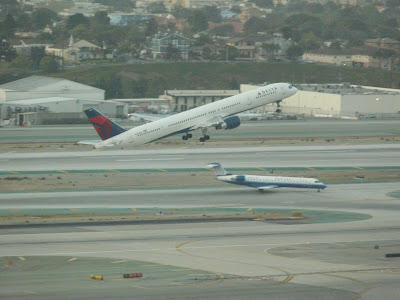
Despite the recent paucity of entries, the Wake Turbulence series lives on. As I mentioned in the previous entry, the Boeing 757-200 has had the distinction of having multiple requirements for wake turbulence separation. As of last week, that has changed. The FAA has amended the weight requirement for heavy jet classification from the previous 255,000 lbs to 300,000 lbs, which is equivalent to the ICAO standard of 136,000 kg. We have not adopted the rest of the ICAO standards, however, so we still use "small" and "large", which are approximately comparable to the ICAO "light" and "medium".

This amended weight for heavy jets has thus reclassified all B757's; none are now considered to be heavies - including the previously heavy -300 model. According to the results of at least one study, the wake vortices generated by the heavier B753 decay faster than those created by the B752. So we no longer have to double-check the heavy status of B752's; nor do we apply heavy separation behind B753's. However, the B757's anomalous "not quite a heavy" status continues. When the B757 is the trailing aircraft, we treat it as a large. But when the B757 is the leading aircraft, the succeeding aircraft receives an extra mile of separation. Generally, this means that a large behind a B757 (of any model) receives four miles of wake turbulence separation. That same large will get five miles behind a heavy jet, or three miles behind another large.

 American B757-200's: Might have been heavies . . . but now they're not
American B757-200's: Might have been heavies . . . but now they're not
 B753's: No longer a heavy . . . but still a B757
B753's: No longer a heavy . . . but still a B757 American B752 taxiing out as a B762 departs (the B762 is still a heavy)
American B752 taxiing out as a B762 departs (the B762 is still a heavy)
 One of each: B753 on the runway; B752 on the ramp or taxiway.
One of each: B753 on the runway; B752 on the ramp or taxiway.None of them are heavy anymore.

 Family photos
Family photos Here's a bonus shot: Avianca showed up with this B752 over the weekend; normally they use a B762 between LAX and Bogota.
Here's a bonus shot: Avianca showed up with this B752 over the weekend; normally they use a B762 between LAX and Bogota.
Dear CAP:
ReplyDeleteI've been listening to LAX final App for a couple of days and nights.. it seems many if not - like? - ?? 80% are called out as Heavies; triple 7's etc.. but i am not informed enough to know why your saying theses big boys are No longer heavy is it because there are A330/Airbus and B762 they just dwarf a standard 747..? (reply is not necessary I'm just wondering out loud..)
I like your blog i do not think i had seen what a 777 looked like nor a real life pic of a Dream liner plus a host other what i would call Heavy jets.
THANKS SO much for your blog!
We get plenty of heavy jets at LAX: A330, A340, B747, B767, B777, B787, DC10, and MD11 are the most common; occasionally we'll have a AN-124, C5, C17, or DC8. Even less common are the B707 and the L-1011.
DeleteThe point of this particular post was that, for a while, B757-300s and certain B757-200 models were also considered "Heavy" jets. Then our rules were changed such that no model of B757 was a heavy. We still treat them as wake turbulence aircraft, just not as heavies.
these are beauty's! Thanks
ReplyDelete